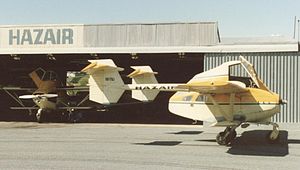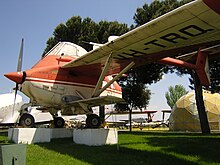Transavia PL-12 Airtruk
| PL-12 Airtruk | |
|---|---|

| |
| PL-12 Airtruks of Hazair at Albury airport, New South Wales, in March 1988 | |
| Role | Agricultural aircraft |
| National origin | Australia |
| Manufacturer | Transavia Corporation |
| Designer | Luigi Pellarini |
| First flight | 22 April 1965 |
| Produced | 1966-1993 [1] |
| Number built | 138 |
| Developed from | Bennett Airtruck |
The Transavia PL-12 Airtruk is a single-engine agricultural aircraft designed and built by the Transavia Corporation in Australia. The Airtruk is a shoulder-wing strut braced sesquiplane of all-metal construction, with the cockpit mounted above a tractor-location opposed-cylinder air-cooled engine and short pod fuselage with rear door. The engine cowling, rear fuselage and top decking are of fibreglass. It has a tricycle undercarriage, the main units of which are carried on the lower sesquiplane wings. It has twin tail booms with two unconnected tails. Its first flight was on 22 April 1965, and was certified on 10 February 1966.[2]
A Transavia PL-12 featured in the 1985 movie Mad Max Beyond Thunderdome.
Design and development[edit]

It was developed from the Bennett Airtruck designed in New Zealand by Luigi Pellarini. It has a 1 tonne capacity hopper and is able to ferry two passengers as a topdresser. Other versions can be used as cargo, ambulance or aerial survey aircraft, and carry one passenger in the top deck and four in the lower deck.
The Airtruk is also sometimes known as the Airtruck. Because the name "Airtruck" was registered by the New Zealand companies Bennett Aviation Ltd and Waitomo Aircraft Ltd, for their PL-11, Transavia found another name for their PL-12 ("Airtruk").
July 1978 saw the first flight of an improved model, the T-300 Skyfarmer, which was powered by a Textron Lycoming IO-540-engine. This was followed in 1981 by the T-300A with improved aerodynamics.[2] Transavia ceased production of the T-300 in 1985.
In 1982, certification was undertaken to enable sales in the North American market. Assistance was provided by the Aeronautical Research Laboratories (ARL) of the Defence Science and Technology Organisation (DSTO) and extensive tests carried out on the ground and in subsequent flight flutter clearance trials. ref. DSTO Structures Tech. Memo. 341
In 1985, an extended version was produced and released as the T-400. The engine was changed from a 6-cylinder to an 8-cylinder and the tail booms extended by 750 millimetres (30 in). Other minor changes were made to the aerodynamics. Flutter clearance tests were again carried out by ARL and manufacture proceeded.[3]
An isolated flutter incident was reported in 1986 involving violent oscillations of the rudder and tail boom on the T-400 during a delivery flight. Investigations were carried out by ARL, and a split mass balance arm was fitted to each rudder. Prior to this, the aircraft had relied on frictional damping provided by the lengthy control cables. The modified aircraft was tested both on the ground and in flight trials in March 1988 over Port Philip, near Melbourne, Australia. All attempts to induce the oscillations showed that there was no indication of a mode of vibration becoming unstable. The maximum speed achieved was 160 knots (180 mph; 300 km/h) in a steep dive. Oscillations were induced with an air operated tool fitted with an out-of-balance rotating mass. This device had a rotational speed from 18 Hz down to zero for each charge of the compressed air cylinder.[4]
At least 120 had been built by 1988.[2]
Operations and survivors[edit]
As of 2008, there are at least three examples in museums in New Zealand, with an additional one being restored to airworthy status. The second prototype is preserved in the Powerhouse Museum collection, Sydney, Australia.[5]
There is one Transavia PL-12 Airtruk on display and under restoration at the Danish Air Museum at Stauning Vestjylland Airport in western Denmark.[6]
There is one airworthy Airtruk in Ecka airfield near Zrenjanin, Serbia, two airworthy T300A models in Albury (Hazair PL), Australia, and one airworthy PL12 model in Tooma, Australia. [citation needed]

There is another that is airworthy and flying frequently (most weeks) at Temora Airport, New South Wales, Australia
There is one located in the Bathurst Aerodrome, New South Wales, Australia.
There is one located at the Queensland Air Museum, Caloundra, Queensland Australia.[7]
There is one located at the Museum of Aeronautics and Astronautics, Cuatro Vientos (Madrid) Spain.[8]
Variants[edit]

- PL-12 Airtruk
- Single-engined agricultural aircraft. Powered by 300 hp (224 kW) Rolls-Royce Continental IO-520-D
- PL-12U
- Multi-purpose utility transport, air ambulance, aerial survey aircraft.
- T-320 Airtruk
- Powered by a 320-hp Continental/Rolls-Royce Tiara 6-320-2B piston engine.[9]
- Skyfarmer T-300
- Powered by Lycoming O-540 engine.
- Skyfarmer T-300A
- Improved version of the T-300.
- Skyfarmer T-400
- Enlarged, more powerful (400 hp (298 kW) Lycoming O-720 engine.[2]
- PL-12 MIL
- Proposed multi-role utility transport, air ambulance, forward air control, light attack, counter-insurgency aircraft. Also known as the M-300.[10]
- PL-12 550T
- Proposed variant powered by a 550 hp (410 kW) Pratt & Whitney Canada PT6A turboprop engine.[10]
Specifications (PL-12 / PL-12U)[edit]
Data from [11] Jane's All the Worlds Aircraft 1988-89 [2]
General characteristics
- Crew: 1
- Capacity: 2 pax / 2,000 lb (910 kg) dry chemicals or 818 L (216 US gal; 180 imp gal) liquids
- Length: 21 ft 0 in (6.4 m)
- Wingspan: 39 ft 4 in (11.98 m)
- Height: 9 ft 0 in (2.74 m)
- Wing area: 256 sq ft (23.8 m2)
- Airfoil: NACA 23012
- Empty weight: 1,709 lb (775 kg) :: PL-12U 1,830 lb (830 kg)
- Max takeoff weight: 4,090 lb (1,855 kg) (agricultural mission)
- Fuel capacity: 181.5 L (47.9 US gal; 39.9 imp gal) in two upper wing fuel tanks with optional second tank in each wing for a total of 373 L (99 US gal; 82 imp gal)
- Powerplant: 1 × Rolls-Royce/Continental IO-520-D 6-cyl. air-cooled horizontally opposed piston engine, 300 hp (220 kW)
- Propellers: 2-bladed McCauley D2A34C58/90AT-2 constant speed metal propeller, 7 ft 4 in (2.23 m) diameter
Performance
- Maximum speed: 103 kn (119 mph, 191 km/h) :: PL-12U 112 kn (129 mph; 207 km/h)
- Cruise speed: 95 kn (109 mph, 176 km/h) at 75% power at Sea level ISA
- PL-12U 102 kn (117 mph; 189 km/h)
- Stall speed: 52 kn (60 mph, 96 km/h) flaps down
- PL-12U 50 kn (58 mph; 93 km/h)
- Never exceed speed: 180 kn (210 mph, 330 km/h) :: PL-12U 150 kn (170 mph; 280 km/h)
- Rate of climb: 600 ft/min (3.05 m/s) :: PL-12U 4.066 m/s (800.4 ft/min)
- Wing loading: 16 lb/sq ft (79 kg/m2) :: PL-12U 73 kg/m2 (15 lb/sq.ft.)
- Power/mass: 0.12 kW/kg (0.073 hp/lb)
- PL-12U 0.129 kW/kg (0.078 hp/lb)
See also[edit]
Aircraft of similar role, configuration, or era
References[edit]
Notes[edit]
- ^ "The Transavia Airtruk & Skyfarmer" Airliners.net. Retrieved 27 October 2013.
- ^ a b c d e Taylor 1988, p.7.
- ^ Goldman, A.; Galea, S. (1985). Flutter clearance tests on a Transavia PL-12/T-400 Skyfarmer. Melbourne: Aeronautical Research Laboratories. ISBN 9780642097453.
- ^ Goldman, A.; Rider, C.D.; Piperias, P. ARL-STRUC-TM-515 Flutter investigations on a Transavia PL12/T-400 aircraft. Melbourne: Aeronautical Research Laboratory.
- ^ Transavia Airtruk PL-12, Australia, 1965, VH-TRN Powerhouse Museum. Retrieved 3 August 2008.
- ^ "Danmarks Flymuseum - Forside". Flymuseum.dk. Retrieved 2022-05-02.
- ^ "TRANSAVIA PL-12 AIRTRUK ZK-CWX C/N 818 – QAM, Queensland Air Museum". qam.com.au. Archived from the original on 2017-03-18.
- ^ "Las novedades del Museo del Aire que también se podrán ver en agosto - Noticias Defensa España". 6 August 2018.
- ^ Taylor 1977, p.8.
- ^ a b Donald 1997, p.877.
- ^ Taylor, John W.R., ed. (1975). Jane's all the world's aircraft, 1975-76 (66th annual ed.). New York: Franklin Watts Inc. pp. 9–10. ISBN 978-0531032503.
Bibliography[edit]
- Donald, David (editor). The Encyclopedia of World Aircraft. Leicester, UK: Blitz, 1997. ISBN 1-85605-375-X.
- Taylor, John W R. (editor). Jane's All the Worlds Aircraft 1976-77. London:Jane's Yearbooks, 1976. ISBN 0-354-00538-3.
- Taylor, John W R. (editor). Jane's All the Worlds Aircraft 1988-89. Coulsdon, Surrey, UK: Jane's Information Group, 1988. ISBN 0-7106-0867-5.
External links[edit]
- Transavia PL-12 Airtruk, kiwiaircraftimages.com
- Airtruk Capability, Transfeild Promotional Video
- The First Airtruks, Transfeild Promotional Video
